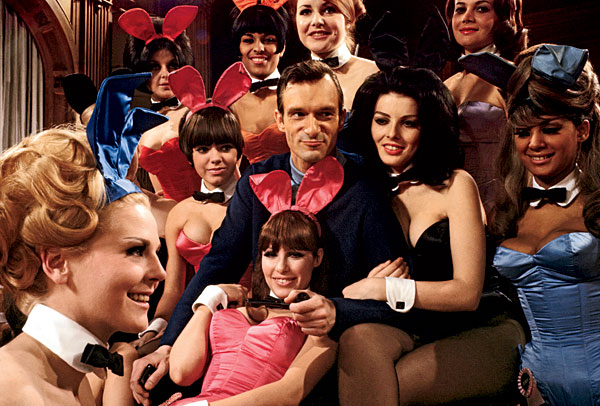
At the hop: Hefner and friends huddle at the Playboy Mansion in 1966. Photo Gallery »
She is beautiful still in the spring sunlight, the form, the façade, the long, lovely lines. Not young, but quite fashionable, striking the same winsome pose she held when her presence along this glittering Gold Coast stretch could stop men in their tracks. They would stand before her bewitched then, desperate for her favor. Depending on who they were, it would be granted—though not always. She could be fickle that way. But such was her power, her mystery, that she never wanted for suitors.
That was long ago. The men no longer stare. They pass now with barely a glance. These days, the four-story brick and limestone Victorian-style manor house is just a building.
But for one gilded period some 40-odd years ago, 1340 North State Parkway was much more. In the abstract, it was both the epicenter of a new sexual freedom and an object of scorn; more concretely, it was the setting for some of the most notorious, celebrity-filled parties of its time. Where else might you see Frank Sinatra chuckling at a gorgeous naked woman diving into an indoor pool filled with other gorgeous naked women? Meet Joe DiMaggio and Dean Martin and Warren Beatty and the Rolling Stones in the same ballroom? Slide down a fireman’s pole to an underwater bar lit by the sparkling green of an aquarium window through which yet more gorgeous women could be seen cavorting like so many mermaids?
The building, of course, was the Playboy Mansion—the original Playboy Mansion—at a time when its owner, a West Side boy named Hugh Marston Hefner, ruled the city, if not the world.
Back then, the Playboy imprimatur festooned Chicago and environs—lines stretched outside the Playboy Club on Walton Street; the word “Playboy” blazed atop the Palmolive Building in nine-foot-high letters. Chicago was home to the Playboy Towers Hotel and the Playboy Theater, and the 1,000-acre, 300-room Playboy resort aroused sleepy Lake Geneva. It was an era when Playboy Bunnies bicycled to Schwartz’s on Rush to pick out merry widow corsets; when Playmate centerfolds struck seductive poses in studios on the Magnificent Mile; when the TV show Playboy’s Penthouse hepped it up with jazz greats in a Loop studio.
It’s been so long since Hefner lived in the Chicago mansion that these days it’s hard to believe the place existed, much less that it still stands. And, yet, there it is, beautiful on a sunny spring day, an old flame, an apparition, a silent witness to a strange, singular era in a town she loved and lost.
***
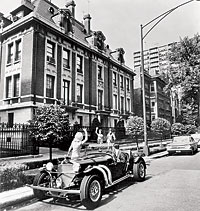
During the 1960s, life inside the Playboy Mansion was a decade-long frolic Photo Gallery »
Hefner is back there, in his mind’s eye, the day I meet him at his current home—Playboy Mansion West, near Beverly Hills. He sits on a plum-striped couch in the library, a dim parlor that features a bare-breasted ceramic bust of Barbi Benton, one of Hefner’s enduring loves and the woman partly responsible for his leaving Chicago for good in 1975.
He is 83 now, his hair thinned and woven with white. He is hard of hearing in the right ear, so I am asked to sit to his left. He wears his trademark crimson smoking jacket draped, as always, over silk pajamas, which today are black. He discarded his pipe many years ago, on his doctor’s advice, after a mild stroke in 1985. But that missing piece of stagecraft, deployed in the fifties to make himself look sophisticated, hasn’t diminished the image, the bearing, the great natural charisma, the reality of who he is. He is talking about the L.A. mansion, telling me, as he does all interviewers, that it is his spiritual home. Moving here, he explains, was the best thing he’s ever done.
Still, as he speaks, his voice conveys wistfulness, and he concedes that he looks back to those years in Chicago fondly. Seeing him so at ease in the lap of his current luxury, it’s hard to imagine he would long for the grit of the Windy City, particularly given the painful chain of events that sealed his desire to leave. But so powerful were those days, those memories, that the King of Fantasy, in this late afternoon of his life, admits he would love to turn back the clock, if only for a moment. “What I would love to do,” he says, his voice taking on a curious poignancy, “would be to get in a time machine and simply walk back into that mansion in 1965.”
Photography: (top) Burt Glinn/Magnum Photos, (bottom) Courtesy of PLAYBOY Magazine © by Playboy
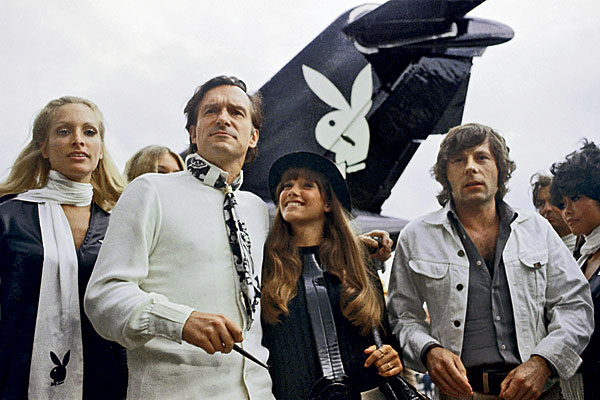
Hefner, in Paris in 1970, with his then-girlfriend Barbi Benton and the movie director Roman Polanski Photo Gallery »
Hefner has always enjoyed a deeply romantic streak, and when he first saw the grand manor at 1340 North State in the winter of 1959, he fell hard. “He loved it,” recalls his friend and colleague Victor Lownes. “It met his needs perfectly.”
At the time, Hefner had achieved a measure of fame, both on the strength of his racy, daring new magazine and his up-by-the-bootstraps story—a Chicago boy hocks his furniture to start a magazine that makes him wildly rich and puts him at the forefront of one of the most powerful cultural movements of the century: the sexual revolution. All of this in a rust-belt city under the sway of its newly crowned potentate—da’ mayor—Richard J. Daley, a national political player, but a buttoned-up old-school square who banished underlings who fell short of his deeply Catholic, almost fusty sense of propriety. But it wasn’t until the publisher started throwing his parties at 1340 North State that Hefner became an icon.
Built in 1899 for a prominent Chicago doctor named George Isham, the 72-room mansion had been one of the famed residences of its day, having entertained such guests as Theodore Roosevelt. Guarded by imposing wrought iron fences, the brick and stone structure offered spectacular possibilities for a newly crowned King of Pleasure, starting with a 60-foot-long, 30-foot-wide ballroom large enough to accommodate hundreds of guests, a giant marble fireplace, inlaid teak floors, oak-paneled walls, a grand staircase, and bronze chandeliers. The basement offered the perfect location for the indoor pool Hefner had dreamed of having, with an adjoining garage where he could store his custom-built Mercedes convertible.
Hefner snapped up the mansion for $400,000, then quickly sank hundreds of thousands more into renovations. Within months, he had constructed a sybaritic paradise that was part salon, part Roman bath, part fortress, and part show-palace, all two blocks from Lake Michigan and a bunny hop from the teeming bars of Division Street. In addition to the kidney-shaped tropical pool, which featured a “woo grotto” reached by plunging through a cascading waterfall, the house included a game room, an underwater bar reached via fireman’s pole, a bowling alley, a steam room, a tanning room, and a descending movie screen installed in the ballroom on which guests could take in first-run flicks. Two suits of armor guarded the entrance and a museum’s worth of original artwork adorned the walls, including a huge Picasso over the fireplace.
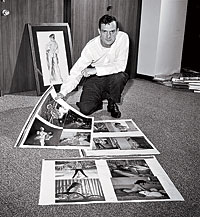
Hefner scans photos shot for Playboy in 1961 Photo Gallery »
Upstairs were lavish guest suites nicknamed the Blue Room and the Red Room—sleeping accommodations for honored guests—and double rooms reserved as dorm space for 25 to 30 Bunnies at the soon-to-be-opened Playboy Club. A fleet of butlers and a fully staffed kitchen catered to the whims of Hefner and his guests, who could order off of an extensive room service menu around the clock. And then there was Hefner’s bedroom, which featured plush white carpet, a Jacuzzi large enough for 12, and, most famously, an enormous rotating round bed fitted out with buttons with which Hefner could control the television, stereo, and lights.
The finishing touch was a gift from Hefner’s associate publisher, A. C. Spectorsky, a brass plaque bearing the Latin phrase Si Non Oscillas, Noli Tintinnare. Attached to the front door, its English translation provided a cheeky warning, as well as a credo for both house and master: “If You Don’t Swing, Don’t Ring.”
Previously, you might have found Hefner prowling the Rush Street triangle in the wee hours—nightclubs like Cloister on Rush, or the Black Orchid, or The Chez Paree. In those pre-mansion days, he would make the rounds with an after-hours band of brothers: Shel Silverstein, the bald, bearded Chicago cartoonist; Don Adams, the comedian who would gain renown as the star of the television comedy Get Smart; and Victor Lownes, the suave, womanizing impresario of the Playboy Clubs—number two man at Playboy, and one of Hefner’s closest friends. Once ensconced at 1340, however, Hefner found few reasons to venture out.
Before Chicago could catch its breath, Hefner had bought a second building, a five-story living embodiment of the Playboy lifestyle that would create an equal stir and generate an even greater amount of publicity. The Playboy Club at 116 East Walton Street was patterned after an elegant members-only Chicago establishment called the Gaslight Club, where patrons were served by beautiful showgirl waitresses dressed in abbreviated costumes. Playboy magazine had run a small feature on the Gaslight and the response was astounding. “When I saw that reaction, we felt we had something much larger,” says Lownes, who was made director of promotions for the Chicago club, and who would eventually become lord of a vast network of Playboy clubs across the United States and abroad.
Photography: (top) Michael Lipchitz/Associated Press, (bottom) George Brich/Associated Press
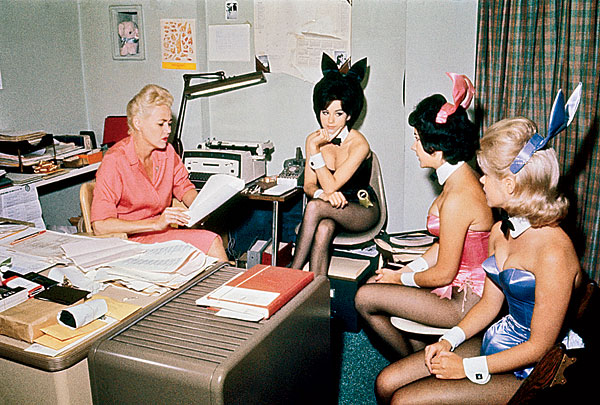
In the mid-sixties, a “Bunny Mother” confers with her young charges Photo Gallery »
The new club featured several floors of sophisticated entertainment and fine food and drink in a setting designed to be the embodiment of the mod, hip, upwardly mobile lifestyle portrayed in the magazine. The star attraction of the dark, cozy leather-and-teak lair, of course, was the newly created Playboy Bunny, a typically busty, always pretty young woman dressed in a soon-to-be iconic one-piece satin swimsuit costume, stylized rabbit ears, cotton tail, and cleavage.
When it opened on February 29, 1960, the place was more than a hit—it was a sensation. Despite the frigid weather, long lines stretched out the door, and cars pulled up two and three deep. For $50, patrons received a lifetime membership and a key stamped with the Playboy logo. Diners enjoyed $1.50 meals and drinks, while listening to top-flight comedians and singers. Among the acts was a young black comedian named Dick Gregory—whose controversial hiring established Hefner as a staunch supporter of racial equality. Nearly 17,000 keyholders and their guests visited the club in the first month alone. “People were coming to Chicago from all over the world,” says Hefner.
In quick order, Playboy went from a low-key, barely noticeable suite of offices to a high-profile presence that dominated downtown. In the process, it began shouldering aside the long-held image of Chicago as a mobster enclave and replacing it with a new, hip, slightly naughty aura. “Chicago has become the sex symbol capital of the United States,” the syndicated columnist Art Buchwald wrote in a 1962 column. “If this is the wrong image of Chicago, it must be blamed on Playboy’s publisher, Hugh Hefner. . . . We were invited to his house one night to look around, which is to Chicago what being invited to Buckingham Palace is to London.”
Not everyone was pleased. The Catholic establishment disdained Playboy and so did Daley. “I had a very cordial relationship with Daley Jr. [Richard M. Daley], but never had a very friendly relationship with the father, because the father was in the hands of the church,” says Hefner. The two first clashed over the location for an event that would mark a defining moment in the development of the young magazine: the 1959 Playboy Jazz Festival.
Having first granted permission for the event to be at Soldier Field, Daley reversed himself after the Catholic church objected. The move turned out to be a blessing. Not only were the intimate confines of the new venue, Chicago Stadium, better suited for the concert, but it rained during the event. Still, Hefner and his magazine were on notice.
Among the public at large, however, the feeling toward Playboy seemed one of voyeuristic fascination. “Hardly any young man new to the street and the neighborhood can resist the temptation to glance at the imposing [mansion],” a 1969 story in the Chicago Tribune observed. “Sometimes men stop and stare, as if expecting to see the nubile Playboy Bunnies themselves cavorting at the few windows that remain undraped.”
Whatever Chicago’s opinion of Hefner, he wasn’t going away. For him, his magazine, and the people who were fans of both, the fun was just starting.
* * *
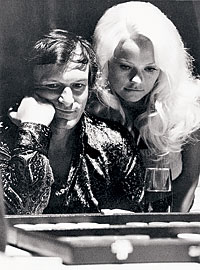
Hefner with the Playmate Karen Christy Photo Gallery »
It was an extraordinary sight: the beautiful young woman, trailing a tangle of flowing, dark brunette hair, clip-clopping down Inner Lake Shore Drive on a gorgeous black gelding, riding from her Near North stables through Lincoln Park, over to North State Parkway, and up to the gates of 1340. The year was 1963, and Patti Reynolds, a Playboy Bunny and soon to be centerfold, and her horse, Frankie, were making their daily trip to the mansion, where she had moved into a small studio apartment on the same floor as the Bunny dorm.
“I would go get him about 8 o’clock, 9 o’clock in the morning, and I would ride to the mansion, right up to the butler’s pantry,” recalls Reynolds. “Hef would come out and pet the horse in the morning and there was a Bunny I was friends with, Marika [Lukacs], and she’d get on the back of the horse with me, and we’d go riding down State Street. In those days, the police would stop you, but just to talk because they knew who we were—Playboy Bunnies.”
Reynolds was 17 when she talked her way into a waitress job at the Gaslight Club, and still under age when she answered an advertisement in the Tribune seeking “beautiful, charming and refined young ladies” to work in the new Playboy Club. “I was afraid of everything,” she says. “I felt these girls were so beautiful. I couldn’t believe I had been hired.”
Reynolds, who would become the September 1965 Playmate of the Month, says the rules were strict, but that didn’t stop her or other Bunnies from making the occasional mischief. “I remember working with another Bunny,” she recalls. “She was very busty. When we worked the show rooms, she would be sitting on a chair, and she would pull her costume down. Some guy watching the show would grab his friend and say, ‘Look at that!’ By the time the other guy looked over, she had covered up and was sitting there like nothing had happened. Every so often we’d get fired by Hef’s brother, Keith, and we’d go running to Hef—‘Boo hoo, your brother fired us’—and he’d say, ‘All right, Patti, go back to work, but be a good girl this time.’”
Dianne Chandler, who was both Playmate of the Month and cover girl for the magazine’s September 1966 issue, was working as a waitress at the Pancake House in Champaign-Urbana when she saw an ad similar to the one that drew Reynolds. “I had just fallen off the turnip truck,” says Chandler, who grew up in Oak Park. She got hired and moved into the mansion, where she met Shel Silverstein, who had taken up semi-permanent residence in the Red Room.
“I had talked Hef into letting my baby sister stay for a night. So we were both in our baby doll jammies, sitting in bed watching TV, and all of a sudden the door opens from the bathroom and in pops this bald head. That was the time when he wore these kind of Mexican looking pants, with fringy bottoms and sandals, and he had his guitar and said, ‘What’s going on here?’ The next thing we knew, he jumps onto the bed with my sister and me, curls his feet under him Indian style, starts strumming the guitar and singing these hysterically off-color songs.”
Reynolds recalls walking past the steam room one day when a hand reached out and pulled her into a fog of giggling Bunnies. “Everybody was squealing and laughing and hands were everywhere,” she says. “When the steam cleared I looked to see who had pulled me in and it was Hugh O’Brian, the actor who played Wyatt Earp.” (“Could’ve been,” O’Brian told me when I reached him by phone at his Los Angeles home.) She escaped just in time to run into Hefner. “Having a good time, Patti?” he asked.
Photography: (top) Bettmann/Corbis, (bottom) Courtesy of PLAYBOY Magazine © by Playboy
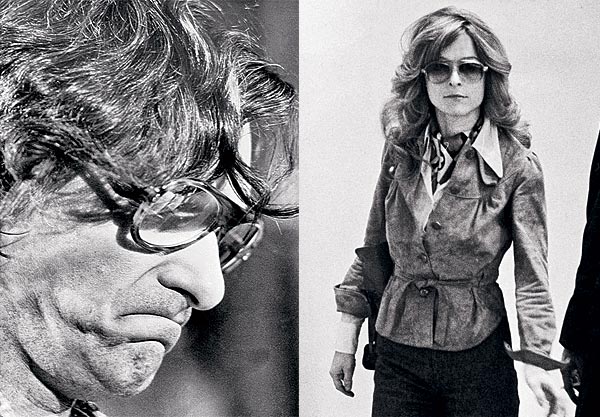
A distraught and disheveled Hefner reacts to the 1975 suicide of his friend and aide Bobbie Arnstein, which occurred during a drug investigation that circled around Playboy Photo Gallery »
Beneath the fun-and-games veneer lay a more complicated reality. Many of the women chosen to be Bunnies or Playmates came from small towns and less-than-scintillating jobs as secretaries or shop girls. Suddenly, they were living in the most famous private residence in America, attending celebrity-studded parties, living with a staff of butlers at their disposal. By day, they either slept or shopped or sunned on a rooftop deck (much to the delight or indignation of guests at the nearby Ambassador Hotel). By night they worked in the hottest club in town.
The women I talked to said they enjoyed their time at the mansion and were grateful to Hefner for welcoming them into a glamorous—and lucrative—world they would otherwise have never known. Many describe him as an avuncular figure, who was deeply loyal and who seemed to care about their well-being. Chandler, for instance, once confessed to Hefner that she was having financial troubles. “He called a guy over and said, ‘Bring me the checkbook,’ and he wrote a check to me for five grand. He told me, ‘You’ll pay it back—I know you will.’ And I did, every cent.”
On the other hand, the women of the mansion faced limits, hierarchies, and an unabashed male culture. The Bunny dorm, for example, had rules: no boyfriends in the house, no pets. Coming in at all hours was discouraged. Bunnies were not allowed to date their customers or their managers. There was a pecking order: Playmates were given their own apartments, while Bunnies lived four to a room.
More to the point, men ruled the hutch. Hefner could sleep with whomever he wanted, while the women were expected to remain loyal. “It was guilt-free for him,” says Joyce Nizzari, who was Playmate of the Month for December 1958, and had a brief fling with Hefner. “I remember being absolutely crushed when I found out Hef was seeing other women. But when I began to see other men, he couldn’t accept that. He would tell you it breaks his heart and that the romance is pretty much over.” Painful as such things were, says Nizzari, they were simply rules one didn’t question—not if you wanted to remain in Hefner’s orbit. (She has stayed friends with Hefner and currently works as an assistant at the L.A. mansion.)
A double standard also applied to Hefner’s close friends who either worked or played at the Playboy Club. Specifically, the no-fraternization rules didn’t apply; Lownes, for example, dated numerous Bunnies. The Bunnies weren’t obligated to sleep with Hefner’s pals, but some say they felt pressured. A Bunny named Pearl Bey Price, for example, quit after months of passes by one of the senior managers at the club. “He fired me again and again,” she said in The Bunny Years, a collection of where-are-they-now stories. “But each time Arnie Morton (one of the original partners) would ask me to come back, promising he would speak to [the manager] about leaving me alone.” Price said she became so fed up that one day she changed out of her Bunny outfit, found the manager, and flung the costume in his face. “You’re always trying to get in my pants,” she recalled saying, before quitting for good. “Here’s your chance. Have a ball!”
At the mansion, women could draw the line, but most wanted to join the fun. “I was never expected to do anything untoward,” says Marilyn Cole, Playboy’s first full frontal nude Playmate and Lownes’s wife since 1984. “But I [enjoyed] behaving in a certain way and I did. I think the thigh-length boots and hot pants confirmed that.”
Patti Reynolds caught on the hard way. “I kind of kept to myself at first—I would come home from work and go right up to my room—and I noticed I wasn’t getting invited to any parties,” she says. “So I asked Hef what was going on and he said, ‘We don’t ring if you don’t swing, Patti. You read the sign.’”
Photography: (Top Left) Bettmann/Corbis, (Top Right) Roy Hall/Chicago Tribune
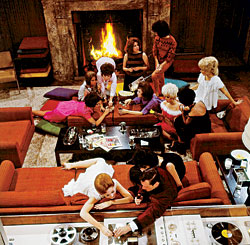
Hefner shows off the ballroom’s vaunted sound system Photo Gallery »
If wangling an invitation could be hard for a Bunny, for ordinary folks a mansion party was “about as easy to get into as the gold vault at Fort Knox,” according to one columnist of the day. “It was the place people wanted to stay, wanted to party,” says Hefner.
The glittering, Gatsbyesque affairs drew hundreds of guests, including writers, artists, intellectuals, political figures, movie stars, sports figures, models, literary lions—not to mention, of course, a bevy of Bunnies and Playmates. The sights ranged from the curious to the bizarre, the shocking to the silly. A Washington Post article from 1971 marveled: “There was the noted oracle Max Lerner, cautiously twisting with a blonde chick on the parquet floor . . . in an absolute sybaritic atmosphere of eye-searing flashbulbs and shattering rock music, packed throngs of shouting people, smoke and 100-degree heat.” Harold Ramis, who edited the magazine’s “Playboy Party Jokes” column from 1968 to 1970, recalls a 1969 event at which he encountered the cast of the musical Hair splashing nude in the pool and singing “Let the Sunshine In.”
Over the years, a rich and deep mythology has grown up around the parties. Some claim they were sexless affairs as tame as an office picnic. Frank Brady, for example, a former editor and the author of an unauthorized biography of Hefner, writes that at the more than 100 parties he attended, he rarely saw anything remotely close to the freewheeling frolics of popular lore. Steve Byer, a former Playboy marketing director who wrote a searing tell-all about his years at the magazine, described the parties as “screamingly dull.”
Others, however, say the mansion more than lived up to its reputation. “All the rumors you hear about Playboy—they’re true, all of them,” says Laurence Gonzales, an editor and writer with the magazine from 1972 to 1978. “It wasn’t quite Roman in its quality, but it was pretty close.”
Reg Potterton, a writer for Playboy, recalls, “Lots of screwing went on in the Underwater Bar and in the Game Room, on the pool table and under the pool table. There really wasn’t much to do in the house except to do that.”
Hefner says that the level of action depended on who you were, what the function was, and the era in which you attended. “Certainly in the 1960s in Chicago, there was no public sex,” Hefner says. “There was sex going on down in the underwater bar. There was certainly sex going on in the bedroom,” but visions of naked revelers writhing around the mansion were pure fantasy.
There was one notable exception. The 1972 visit by the Rolling Stones was not a party, but a four-day, drug-drenched bender that fulfilled the most fevered imaginings of what went on behind the mansion’s closed doors. From it emerged tales of orgies in the Roman Bath, sex under the grand piano, burned furniture, ravaged rooms, and deflowered virgins. “When the maids cleaned up there were needles all over the goddamn place,” recalled Hefner friend John Dante in Inside the Playboy Mansion. Among the more memorable moments, Hefner would later recall, was a Bunny’s abrupt admission to Mick Jagger that “I want to bite your ass.” Jagger, in a legendary rejoinder, said, “Have at it, luv.”
* * *
Ten blocks—in some ways, a world—away, the editorial staff of Playboy was putting out a magazine that had gone from a 70,000-issue upstart to a circulation behemoth. By its tenth birthday, celebrated in January 1964, magazine sales had reached 2.4 million. In the next four years, circulation would soar to 5 million. By 1972, it would reach its height—an astonishing 7.2 million. Advertising, and money, gushed in.
From the mansion, Hefner, a workaholic who took an almost obsessively hands-on approach to Playboy, issued infamous memos, Brobdingnagian in size, from his bedroom office. For a time, in fact, while he was writing the “Playboy Philosophy”—a multi-part exegesis in the magazine—Hefner became a virtual hermit. He rarely ventured out, working days without sleep fueled on dozens of bottles of Pepsi a day and a Dexedrine addiction that would nearly kill him. (“He became a 24-hour person,” recalls Lownes, who introduced Hefner to the drug, “writing pages and pages of memos. The joke became you had to take a Dexedrine to read them.”) Editors and executives came to dread marathon meetings at the mansion, which would sometimes stretch deep into the night, usually because Hefner was obsessing over some minor detail, a photo caption, some seemingly innocuous wording.
Still, even the office had its share of glamour and sex. “We had all these famous people coming through,” says David Standish, who was hired as an editor in 1967 and now teaches journalism at Northwestern University. “You’d walk in the office one day and there’s Timothy Leary standing there with his arctic blue eyes staring holes in you. The next day, there was Carl Sagan. As a literary person, I got to have dinner with Norman Mailer, who did a piece in the early seventies on Muhammad Ali for us.”
In 1967, when the magazine moved to ten floors of the Palmolive Building at 919 North Michigan Avenue, the setting seemed almost to encourage the sex. “You walk into this building and it looks like the set for a pornographic Star Trek movie,” recalls Gonzales. “The hallways were kind of curving and the surfaces had been covered with a kind of textured ivory-colored plaster. There were little grottoes with sculptures in them and the lighting was very indirect, so you had this sense of kind of being in a cave.”
“The best sex I ever had was in one of those offices,” says James Petersen, who was the longtime Playboy sex advisor. “Occasionally, we would get phone calls from the Westin hotel because there was an art director at Oui magazine [a short-lived Playboy spinoff] who liked to cavort with his models in his office without closing the windows. I just assumed everybody slept with everybody.”
The good news was that the money kept rolling in, fueling the extravagances. Gonzales experienced the magazine’s penchant for excess from his first day on the job: “They gave me this office with a raw silk love seat in it and an Italian marble desk,” he recalls. “And my secretary, who was this vivacious redhead, came in and said, ‘Do you need anything?’ I said, ‘Some pencils and a pencil sharpener would be fine.’ The next day there was this mahogany pedestal next to my Italian marble desk, with an electric pencil sharpener that looked like it had been designed by NASA. On my desk was a piece of pottery that had a bunch of number 2 pencils.”
“Nothing was too much,” says Barbara Nellis, who worked her way up from the marketing department to a senior editor. “There was no trip that couldn’t be taken, no fiction that couldn’t be bought, no event that couldn’t occur. They were just swimming in money.”
Photograph: Courtesy of PLAYBOY Magazine © by Playboy
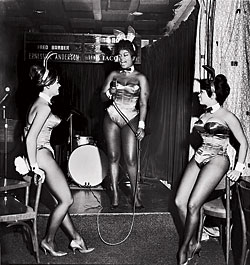
The jazz and blues singer Ernestine Anderson (center), clad in hip-hop regalia, serenades a pair of Bunnies at the Playboy Club in 1962 Photo Gallery »
By the late 1960s and early ’70s, Playboy had reached its zenith. Hefner was a worldwide celebrity and Chicago, at least to some, shone in the reflective glow. The company now boasted “seventeen Playboy clubs, three gambling casinos, four large resort hotels, two movie theaters, a book division, a film division, a record company, modeling and limousine agencies, and dozens of merchandise items emblazed with the Bunny logo,” according to Mr. Playboy. Air travelers at O’Hare would occasionally glance out their windows to see the Big Bunny, a $4.5-million gleaming black converted DC-9 airliner, taxi by. In 1969, the magazine held a National Playboy Bunny Recruitment Day, during which nearly 400 female hopefuls (“in wild-pattern tights,” according to the Tribune) clashed with half a dozen members of Women’s Liberation shouting, “Sisters, know your enemy!”
The party seemed to be in full swing, but the first whispers of last call had begun to sound. Hefner was already splitting time between Chicago and Los Angeles—partly because of his new television show, Playboy After Dark, which was taped in Los Angeles, and partly because of a woman he had fallen in love with: Barbi Benton. An 18-year-old UCLA coed who was an occasional extra on the show, she found the estate that would become Playboy Mansion West, and she refused to put up with Hefner’s cheating on her with a Playmate living at the Chicago mansion, a blond Texas beauty named Karen Christy.
* * *
The love triangle caused problems, but it was more than Hefner’s desire to appease Benton that drove him from Chicago for good. Rather, it was a young U.S. attorney with designs on a different sort of mansion—the one where the Illinois governor lived. James Thompson, then a highly respected corruption fighter, led a prosecutor’s office that had set its investigative sights on Chicago’s most notorious party.
A Tribune headline heralded the beginning of the end on December 8, 1974: “Federal drug probers zeroing in on Hefner.” The publisher, the story said, “has emerged as a prime target of a federal narcotics investigation . . . that centers on suspected illicit drug activities inside Hefner’s Playboy mansions in Chicago and Los Angeles.”
At the heart of the probe was a woman named Bobbie Arnstein. Her title was social secretary, but she was much more to Hefner. Once a romantic interest, Arnstein—lovely, funny, tough, troubled—had since become one of Hefner’s closest friends and aides, as well as a beloved member of the Playboy family. For two years, ever since her boyfriend had been arrested on a charge of smuggling cocaine from Miami to Chicago, the feds had been after her to lead them to the ultimate recipient of the drugs.
Evidence would eventually indicate that it wasn’t Hefner. In fact, other than tolerating some pot smoking, he was generally known to be opposed to drugs, particularly cocaine, and to discourage their use at the mansion. Arnstein refused to cooperate. Then, in March 1974, she was arrested and charged with participating in the smuggling case.
Though questions swirled about the testimony of her chief accuser—the Miami cocaine supplier testifying under a grant of immunity—Arnstein was convicted of conspiracy to distribute cocaine. Despite its being her first offense, Judge Bernard M. Decker slapped her with the maximum prison term of 15 years—with a catch. Decker indicated that he might significantly reduce the sentence pending a study of certain psychiatric and medical problems.
Arnstein’s defenders said the “provisional” sentence was a coercive ploy to give prosecutors a hammer to pressure her into implicating Hefner, a view echoed by the New York Times columnist William Safire. “What clearer invitation to perjury can there be than such a ‘provisional sentence?’” he wrote. “It is one thing to give a cooperative witness a break, entirely another to threaten to let a defendant rot in the slammer until he or she tells the story the prosecution wants.”
Ploy or no, Arnstein continued in her refusal to implicate Hefner, saying he was not, and never had been, involved with drugs.
On January 11, 1975, out on bail pending an appeal, Arnstein checked into what was then the Hotel Maryland on Rush Street after dinner with friends. She was found the next day—dead of an overdose of barbiturates. In her hotel room, she had left behind a suicide note in which she maintained her innocence and defended her boss. “Hugh M. Hefner is—though few will ever realize it—a staunchly upright, rigorously moral man. . . . [H]e has never been involved in any criminal activity which is being attributed to him now.”
Hefner, in Los Angeles when he received word, flew the next day to Chicago, writing out a statement in longhand en route aboard the Big Bunny. Against the advice of his attorneys, he called a press conference at the Chicago mansion. Haggard and trembling, Hefner told the television and newspaper reporters gathered in the ballroom, “Excuse me if I look a bit harried. I’m quite upset.” He accused investigators of, in effect, murdering Arnstein in an effort to get him. The drug probe, he charged, was “a politically motivated, anti-Playboy witch hunt.”
Thompson did not himself prosecute the Arnstein case, but as the head U.S. attorney here, he became the public face of the controversy. He branded Hefner’s “witch hunt” charges ridiculous, saying in an interview, “I don’t want to debate the guy because he’s off the wall.”
Today, Hefner continues to believe that the feds were out to get him, and Thompson continues to dismiss the notion. “There wasn’t the slightest possibility that we would have been after Hefner,” Thompson told me. “His lifestyle, whatever it was, was irrelevant to me, to the office, to anybody else. We just followed whatever evidence we had and wherever it led us.”
A few months after the suicide, Thompson resigned as U.S. attorney to run for governor, an office he would hold for four terms. The drug investigation of Playboy continued for a few more months, then fell apart and was officially dropped.
The damage, however, was done. Arnstein was dead. Hefner was devastated and disillusioned. The magazine staff was demoralized. “It was awful,” recalls Standish. “There was a pall over the whole office, just this leaden atmosphere. Our feeling at the time was that Thompson was just out to get Hefner to make a reputation for himself and that poor Bobbie Arnstein just got caught in the middle. It was a gloomy time, and a paranoid time, because we all thought they were out to get all of us.”
To Gonzales, the Arnstein case signaled, in some ways, the death of an era. “There had been this atmosphere that we were at an extended party that nothing could touch,” he says. “This came as a real shock that changed everything. There was a sense of reality creeping in.”
At the time of Arnstein’s death, Hefner had all but moved permanently to Los Angeles. “Things were very different here from Chicago,” Hefner says. “Tom Bradley, the [Los Angeles] mayor, attended the opening of the Playboy Club and was a frequent guest at the parties and so was Jerry Brown, the [California] governor.” Arnstein’s suicide, however, and Karen Christy’s decision to return to Texas, decided matters for Hefner. “After she died, there really wasn’t a lot of reason for going back,” he told me, in the library at the Los Angeles mansion. “There really wasn’t anything left for me there.”
Over the next few years, Playboy’s presence in Chicago vanished, piece by piece, building by building. In 1976, the Playboy Theater was bought and renamed. The Playboy resort in Lake Geneva was sold in 1981 after years of mounting losses; in 1976, the Playboy Towers Hotel became simply the Towers Hotel. In 1989, a Dallas-based commercial real-estate company bought the Playboy Building and removed the nine-foot-high Playboy lettering that had once dominated the Magnificent Mile skyline.
Chicago’s Playboy Club, which had moved twice since its spectacular opening, hung on at Clark and Armitage until 1986, a shadow of the sensation it had once been. Soon, the few remaining Playboy Clubs around the country closed down, too.
For Patti Reynolds, a businesswoman who stayed in Chicago, the city would never be the same. “I think it changed Chicago,” she says. “You didn’t have that excitement when you came down to the Rush Street area, where you could turn around and bump into Hef, or go into places like Mister Kelly’s and there’d be a Playmate and a couple of Bunnies.”
The fate of the mansion would provide the most curious epilogue. In the mid-seventies, with the magazine’s circulation sliding and Playboy Enterprises struggling amid a recession, Lownes, Hefner’s old right-hand man, was summoned back from England, where he had made himself—and Playboy—a fortune running a Playboy Club and casino. He slashed the payroll, and began looking for other places to cut. The Big Bunny jet was first on the chopping block (it was sold to Venezuelan Airlines for $4.2 million). Next would be the mansion, Lownes told the Tribune on July 28, 1975. Hefner had been there only three weeks in the previous year.
After the story came out, Hefner balked and Lownes sheepishly announced that he had misspoken. But the reality was undeniable. Hefner was gone. The mansion, now tended by a skeleton staff, was finished. The party was over.
The mansion wheezed along on life support, opened for occasional charity benefits and business functions. The last real bash there was in 1978, when Hefner returned for Playboy’s 25th anniversary. For one night, the place recaptured its old glory, attracting celebrities, Playmates, doctors, aldermen, business executives, and models. A couple even swam in the pool—“two fully suited women and a man wearing goggles who made faces in the window of the underwater bar,” according to the Tribune.
As the years passed, Playboy executives struggled with what to do with the place; there was even talk of turning it into a mayor’s mansion. Then, in August 1984, with Hefner’s daughter, Christie, now at Playboy’s helm, the property was leased to the School of the Art Institute, where Hefner had once taken figure-drawing classes. Charged a token $10 a year for five years, the school named the place Hefner Hall, and it turned the former Bunny dorms into sleeping quarters. Students sometimes took impromptu—and unauthorized—tours of the place, astonished to find that the pool, and its grotto bar, though drained, were still there, as was the bowling alley, where a gold bowling ball bearing the inscription “Hef” remained.
Because of the high maintenance costs, however, the school eventually abandoned the property and sold the mansion to a developer in 1993. By 1999, the pool, grotto bar, and bowling alley had all been removed and the building was fully renovated and turned into condos. The only undisturbed remnant of the glory days was the ballroom. It was too beautiful not to keep, the developer decided.
* * *
The party did not stop for Hefner, of course. If anything, the Los Angeles mansion and the parties there have outshone the Chicago originals. In the years immediately after he moved to L.A. permanently, he seemed determined to bury all memories of his Chicago days under a blizzard of sexual pleasures. Soon enough, a new set of tales, scandals, and legends grew up, and within a few years, it was as if the glory days in Chicago were nothing more than some distant, quaint fantasy. As with the endless string of beauties he had wooed, loved, and eventually drifted apart from, Hefner had left the mansion behind.
Now, the empire he created is faltering. In May, the company projected steep drops in ad revenue and posted a first-quarter net loss of more than $13 million. Jerome Kern, the interim chairman and chief executive, announced that “radical changes” were in the works to make the magazine “younger and fresher.” Circulation will be cut and the magazine will be published fewer times a year. At presstime, there were reports that Playboy Enterprises itself—of which Hefner controls 70 percent of the voting stock—was up for sale.
The last constant, it seems, is the man sitting across from me on the shiny striped couch next to the glazed ceramic Barbi Benton bust, searching for the words to describe his feelings toward Chicago, and toward that time of his life. “Mixed emotions,” he says. “It was the good, the bad, and the ugly. You love the good parts about Chicago. It was the city that worked, but it was also corrupt.”
He falls silent for a moment. The room is hushed, the only sound the mournful screech of the peacocks that strut across the lawn. When he speaks again, his voice softens. “It was a magical place, a magical time,” he says. “It’s where the boy grew up and dreamed the dreams. I loved the boy and I loved the dreams.” And he loved the home, he says, the old flame he left behind but never quite forgot, the building that is beautiful still all these years later, though hardly anyone stops to look.
Photograph: Isaac Sutton/Associated Press


